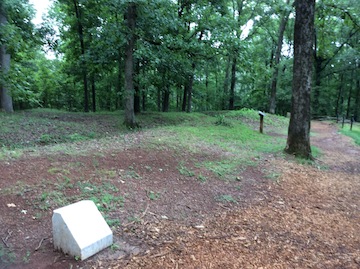The Kennesaw Line: Eyewitness at the Dead Angle

The fighting at the Dead Angle on Cheatham Hill was some of the most brutal in the Civil War, similar to the vicious fight at Spotsylvania Court House. Captain James Hall of the 9th Tennessee Infantry gave a graphic account of the fighting there:
27th of June. On this day, General Sherman assaulted our lines with a heavy force in several places. The most furious assault was made on that part of the line which happened to be occupied by our brigade [Maney’s].
The nature of the ground in our front was such as to give the enemy the opportunity of forming their line of battle within a hundred yards of our works [edit. note – closer to 300 + yards]—entirely out of our sight. Here, General Sherman had concentrated a whole corps and had formed them in five lines, one immediately behind the other. We were not expecting the attack and the part of the works held by Colonel Field’s regiment of our brigade [First Tennessee] immediately on our right, was inefficiently manned, from the fact that Colonel Field, not expecting an attack, had allowed a number of his men to go the rear of the breastworks during the heat of the engagement. So that we had the double duty of keeping off the enemy and changing our position at the same time. It was an extremely hot day and the fight lasted from 11 o’clock A.M. until noon. The ground in front of us was literally blue with Yankees. Their advance column reached our breastworks and planted their flag on them, but the resistance of our men was so determined that they did not dare to come over. Only the breastworks divided the two armies. We had the advantage of having a head-log on our side of the works and the enemy were crowded so thickly that a shot from our men could not fail to hit somebody.
I remember that when I was trying to push my company as rapidly as possible to the right, I noticed one man, Jim Goforth, who had just finished loading his gun, suddenly halt and raise his gun to his shoulder thereby obstructing our movement to the right. I called to him to move forward. His reply was: “Just wait Captain, till I kill this Yankee.” He immediately fired across the breastworks and turning to me with “I got him,” resumed his march.
To show how hot the place was and how incessant the firing, one of my men brought his gun to me, choked and rendered use- less by melted lead. The thin shaving of lead pared off from the minie ball by the grooves of our rifles when melted, ran down into the tubes of the guns when held in an upright position. To prevent this, I ordered the men to reverse their guns after firing so that the lead might run out at the muzzle. When they did this, I saw small round pellets of melted lead poured out of their gun barrels on the ground. After the fight had gone on this way for some time, a terrific cannonade of shell and grape was opened upon the three rear columns of the enemy from one of our batteries stationed on our left in such a position that their fire enfiladed the enemy lines. All this was more than they could stand. After a fierce assault on our lines, which lasted about an hour, they gave up the attack and retired to their sheltered position under the hill in our front. I remember that when I looked at my watch after the battle was over and found that we had been fighting an hour, I was greatly surprised at the length of time. We had been kept so busy that the time seemed shorter. I have mentioned that the Yankees had planted their colors on our works. Notwithstanding a desperate effort on the part of our men to capture these in which three men lost their lives, they were carried away safely by the retreating enemy, but at a great cost of life to them.
After the enemy had retired and we could survey the ground in our front which they had just occupied, a frightful and disgusting scene of death and destruction was presented to our view. During all of the four years of the war, I do not remember ever to have seen the ground so completely strewn with dead bodies.
An interesting series on the battles for the Kennesaw Line. FYI, during a minor (but bloody) skirmish on June 23, Lt. Ambrose Bierce of Hazen’s brigade received a nearly fatal head wound. He would later go on to become a famed short story writer and notorious cynic.